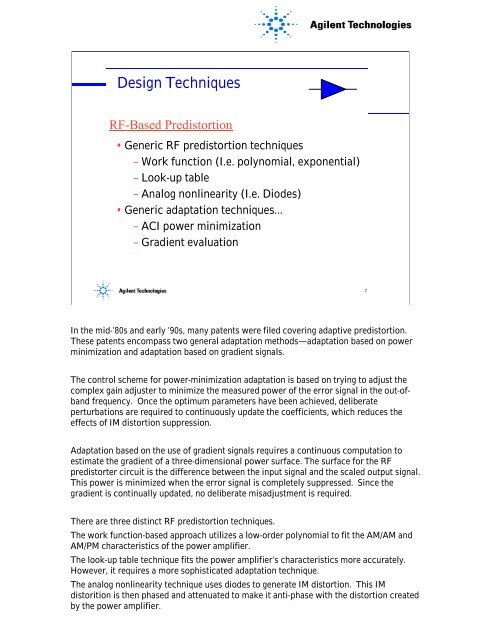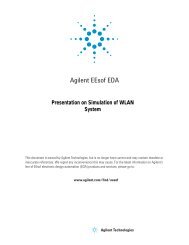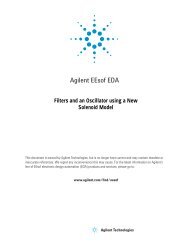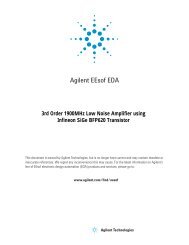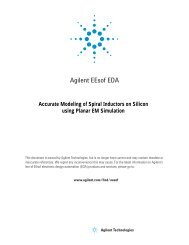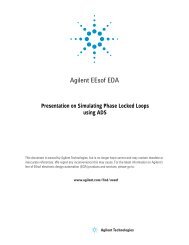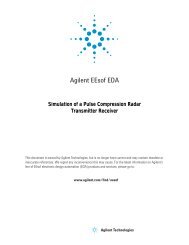Presentation on RF Predistortion of Power Amplifiers - Agilent ...
Presentation on RF Predistortion of Power Amplifiers - Agilent ...
Presentation on RF Predistortion of Power Amplifiers - Agilent ...
You also want an ePaper? Increase the reach of your titles
YUMPU automatically turns print PDFs into web optimized ePapers that Google loves.
Design Techniques<br />
<strong>RF</strong>-Based Predistorti<strong>on</strong><br />
• Generic <strong>RF</strong> predistorti<strong>on</strong> techniques<br />
– Work functi<strong>on</strong> (I.e. polynomial, exp<strong>on</strong>ential)<br />
– Look-up table<br />
– Analog n<strong>on</strong>linearity (I.e. Diodes)<br />
• Generic adaptati<strong>on</strong> techniques...<br />
– ACI power minimizati<strong>on</strong><br />
– Gradient evaluati<strong>on</strong><br />
7<br />
In the mid-’80s and early ’90s, many patents were filed covering adaptive predistorti<strong>on</strong>.<br />
These patents encompass two general adaptati<strong>on</strong> methods—adaptati<strong>on</strong> based <strong>on</strong> power<br />
minimizati<strong>on</strong> and adaptati<strong>on</strong> based <strong>on</strong> gradient signals.<br />
The c<strong>on</strong>trol scheme for power-minimizati<strong>on</strong> adaptati<strong>on</strong> is based <strong>on</strong> trying to adjust the<br />
complex gain adjuster to minimize the measured power <strong>of</strong> the error signal in the out-<strong>of</strong>band<br />
frequency. Once the optimum parameters have been achieved, deliberate<br />
perturbati<strong>on</strong>s are required to c<strong>on</strong>tinuously update the coefficients, which reduces the<br />
effects <strong>of</strong> IM distorti<strong>on</strong> suppressi<strong>on</strong>.<br />
Adaptati<strong>on</strong> based <strong>on</strong> the use <strong>of</strong> gradient signals requires a c<strong>on</strong>tinuous computati<strong>on</strong> to<br />
estimate the gradient <strong>of</strong> a three-dimensi<strong>on</strong>al power surface. The surface for the <strong>RF</strong><br />
predistorter circuit is the difference between the input signal and the scaled output signal.<br />
This power is minimized when the error signal is completely suppressed. Since the<br />
gradient is c<strong>on</strong>tinually updated, no deliberate misadjustment is required.<br />
There are three distinct <strong>RF</strong> predistorti<strong>on</strong> techniques.<br />
The work functi<strong>on</strong>-based approach utilizes a low-order polynomial to fit the AM/AM and<br />
AM/PM characteristics <strong>of</strong> the power amplifier.<br />
The look-up table technique fits the power amplifier’s characteristics more accurately.<br />
However, it requires a more sophisticated adaptati<strong>on</strong> technique.<br />
The analog n<strong>on</strong>linearity technique uses diodes to generate IM distorti<strong>on</strong>. This IM<br />
distoriti<strong>on</strong> is then phased and attenuated to make it anti-phase with the distorti<strong>on</strong> created<br />
by the power amplifier.


